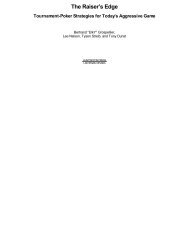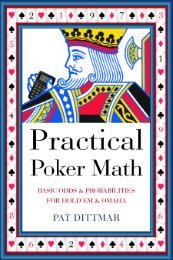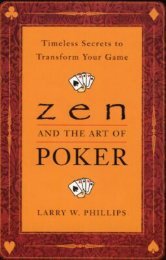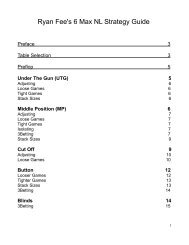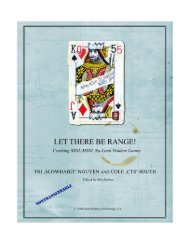Create successful ePaper yourself
Turn your PDF publications into a flip-book with our unique Google optimized e-Paper software.
134<br />
he can call profitably, if we have the best hand, we should still<br />
bet (See Appendix B).<br />
So far in this section, we've only discussed situations where<br />
we’ve known our opponent's hand. When we don't know our<br />
opponent's hand, we have to consider that he is likely to have<br />
implied odds against us. Let's go back to our previous example.<br />
Hero: A♦A♥<br />
Villain: Unknown<br />
Board: T♣J♣6♠.<br />
Again, our villain is loose and aggressive. The pot is again<br />
$7.50, and we have $96.50 behind. We know he can have draws<br />
like KQ as well as draws like 3♣4♣. If a club comes on a later<br />
street, he is capable of bluffing with his unimproved KQ. If a 9<br />
comes on a later street, he is capable of bluffing with his<br />
unimproved flush draw. Now we're in a situation where we can't<br />
play perfectly on the river, and we're probably going to have to<br />
pay him off sometimes. 14 Because he has implied odds, we'll<br />
want to bet larger in this spot to cut down on his implied odds as<br />
much as possible. We're still wanting him to make a bad call,<br />
but we want to make his strategy -EV through the whole hand.<br />
We can now look at implied odds through the eyes of our villain.<br />
Let's say we bet $8 on this flop. The villain has 16% equity to<br />
the turn. This means he needs six times our turn bet. <strong>That</strong>'s $48.<br />
There is already about $24 in the pot. So, he would need to get<br />
14 Notice how valuable hand-reading is. If our opponent is more<br />
predictable, we can practically play like his hand is face up. Against an<br />
opponent who doesn't bluff, we can proceed very simply in this hand.<br />
We bet the largest amount we think the player will call with typical<br />
draws. Then we can simply fold to his aggression if draws are<br />
completed by future cards. Also, notice the value of being perceived as<br />
an aggressive player.





